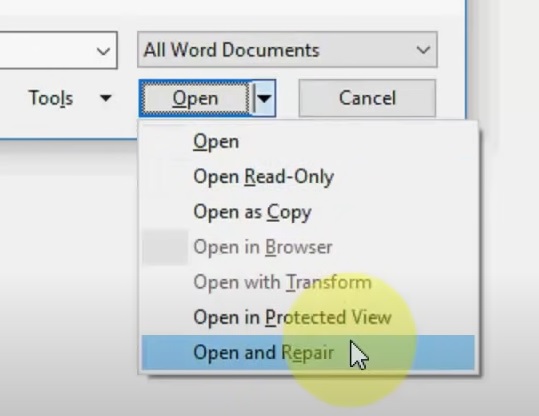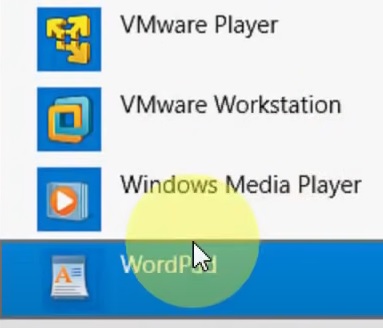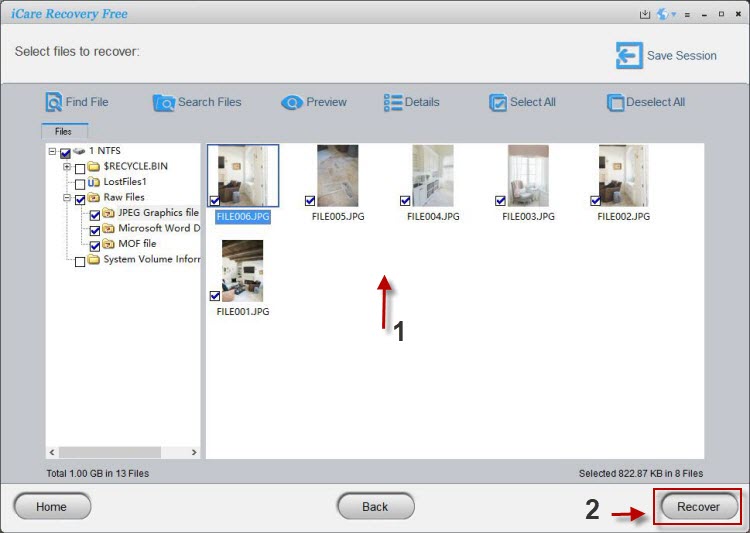Recovered Files Not Opening in Random Code Fixes
Background
This page shares guide about how to repair corrupted files when they are damaged, not opening and it also tells some causes when your files were not recovered correctly or the files have been overwritten partially, then they would not open or display.
Content Navi
Repair damaged word/Excel file that shows random code
Why word document showing junk characters? And how to repair it? - 5 fixes
Word document looks weird and shows special characters after recovery by software, can it be repaired? Microsoft word shows distorted text? Is there any word repair tool that can help show word file in correct format?
#1, if it is a word document that suddenly turned weird symbols or gibberish, it may has been changed by virus
#2, if it's a word document that has been edited by other users or on other platforms, it can be corrected
#3, if it's a word document from somewhere else or you have downloaded from email or from work, it's likely the font is not compatible with your system, or it may contain virus
To get the gibberish word document show the correct content, you may try the following methods.
Solution 1 - When the word has been modified by others or on other platforms or with different word text software, do the following to get it fixed
First, the reason for the garbled code is because the content is in a different encoding format than what word specifies! It is clear that any change made by another tool or system is not the same. Therefore, regardless of the letters or different characters garbled code, using the "delete content formatting method", you can solve the phenomenon of garbled code.
- Step 1: Open File, Options, in the tab settings, find Advanced, uncheck the "Use intelligent paragraph range selection" check box, and then click OK button, the purpose is to repair the file, the following repair file.
- Step 2: copy all the selected messy files one by one, copy all the messy content to the new document, in order to paste the time to remove the format.
- Step 3: Create a new document file.
- Step 4: paste the contents of the copy to a new blank document.
Note: After pasting, choose to keep only the text, so that all the text formatting will be removed.
Finally, select "text only" after saving the document, the document formatting has been removed, the garbled code will be solved.
Solution 2 - Use Microsoft office 'Open and Repair' button, which is available in Office 2016.

Solution 3 - Open in Protected View, which is listed at the place near the open and repair option.
Solution 4 - Try all the options in the Open drop down column: Open Read-Only, Open as Copy etc. to see which one can work for you.
Solution 5 - Open with wordpad, you may open it with the following route:
- Right click word file -> Open with...
- More apps which will show a list of available apps that you can open the word file
- Choose Wordpad to open your word document

Video - watch the following video to get word document repaired when it was in gibberish code (6 methods included)
Solution 6 - If it's the file from a recovery, the software you used may be weak in finding these files in complete mode. You may use the following tool to get better search result.
Why? The following tool provides raw drive recovery that can help find large files in complete mode.

Excel xml shows random code, how to open recovered excel file?
Reason: There is no choice of open method.
1, first open the computer, find the recovered files, right-click the mouse and select Open "Open Method".
2, and then in the pop-up window click to open the "Select Default Program".
3, and then click in the pop-up window to select "Excel", check the box below the "always use the selected program to open such files", enter to determine.
4, and then in the window that pops up you can see the Excel file open.
Video - how to open excel file
Note: If it's the excel file that was from a recovery, it may be damaged during data loss since of data overwritten or the software you used for the recovery was in weak ability for finding a complete copy. You may try some other recovery tools to see more luck.
Recovered Images/Videos Do Not Display
When the large video files or camera photos that are usually large in size have been restored, sometimes they cannot be successfully recovered due to the versatile recovery ability from different software. You may try the following professional recovery tools to see any luck.
#1 iCare Recovery Free provides raw drive recovery that can help recover files in large size
#3 Easeus Data Recovery Wizard
Repair damaged photos with professional photo repair tools/online tool
These two following online photo repair tools is for repairing old images and refresh the color.
Free video repair online tool
You may upload your video to the following url and let the online tool help fix your damaged video.
https://fix.video/fix-video.php
Video Repair Tool - VLC
You may download vlc from its website and then repair your damaged video through this free tool.
VLC download url: https://www.videolan.org/vlc/index.html
Video - how to repair corrupted video with vlc
FAQs
Question: word repair tools
Answer: If your word document is not opening, you may try different editions of Microsoft word to see any luck. Or you may follow the above method to open word especially when it shows weird symbols.
Question: image not opening after recovery, video does not play after recovery, video repair tool?
Answer: Images and video files are usually large that took place many blocks on your memory card if you used it on phone or camera, when data have been deleted or lost by accident, you may try some other professional recovery tools at first to see whether these files can be restored sound.
Why Files Not Opening
Why my recovered files can't open/open all messy codes
Have you ever encountered this situation, that is, you obviously found your lost files, but the recovered files just can't be opened, or opened all messy codes? Here we will introduce the reasons for this situation.
Why formatting may not be recoverable
First let's understand formatting and deletion
When we store a file on the hard disk, the system first writes the file name and size in the file allocation table, and then continues to write the file contents in the file allocation table at the beginning of the data area according to the free space in the data area. Then it starts to write the real content of the file to the data area, and a file storage operation is completed.
When we need to delete a file, the system just writes a delete flag in front of the file in the file allocation table, indicating that the file has been deleted and the space it occupies has been "freed", so that other files can use the space it occupies. So, when we delete a file and want to get it back (data recovery), just use the tool to remove the deletion flag and the data is recovered. Of course, the prerequisite is that no new files are written and the space occupied by the file is not overwritten by new content.
Formatting is similar to deleting in that it only manipulates the file allocation table, but formatting adds the delete flag to all files, or simply empties the file allocation table, and the system assumes that nothing exists on the hard drive partition. The formatting operation does not do anything to the data area, the directories are empty, the contents are still there and the data can still be recovered with the help of data recovery knowledge and appropriate tools.
Note: Formatting is not 100% recoverable, there are cases when the disk cannot be opened and needs to be formatted to be opened. If the data is important, don't try to recover it after formatting, because formatting itself is the process of writing to the disk and will only destroy the residual information.
Several factors influence the success rate of data recovery
The first one: NTFS partition recovery probability is relatively high, generally after deletion or formatting the vast majority can be recovered intact. Certain files sometimes can not be recovered, such as file length is very large or file in the editor to use a long time, this file will form a lot of fragmentation information, after the deletion of the file, this file will not know the file length, it is difficult to recover, for example, some use many years of database files, after the deletion of the file length scanned with data recovery software is 0, can not be recovered. Regularly do disk defragmentation can reduce the occurrence of this situation, but direct disk defragmentation also has risks, please refer to the above need to pay attention to the problem.
Second: FAT or FAT32 partition, after deletion or formatting, larger files or frequently edited and modified files, the recovery success rate is lower, such as frequently edited and modified XLS or CDR files are difficult to recover intact. Those files copied into the file does not move, the recovery success rate is relatively high, such as PDF or JPG, MPG and other documents are not often modified, the recovery rate is still relatively high. This is because FAT and FAT32 partitions use the file allocation table to record information about each file cluster chain fragments, deleted or formatted after the cluster chain fragment information is emptied, those who often edit the modified files due to their dynamic growth in file length, in the file system is generally not stored continuously, so the file fragment information can not be recovered, the file recovery will not be complete.
Third: files deleted after the recycle bin, sometimes the file can not be found. under NTFS, the file deleted from the recycle bin, the file name will be automatically modified by the system to a name like De001.doc, the original file name is destroyed. When your data is lost and you can't find the file name directly, remember not to miss these files that have been renamed by the system. Direct Shift+Del delete will not destroy the file name.
Fourth: repartitioning or deleting partitions or partition table damage, the general partition behind the basic recovery can be complete, the more backward the possibility of damage to the partition is lower, so it is best to put the important data in the more backward partition, not in the C, D disk.
What are the circumstances under which lost data cannot or will not be easily recovered?
1, Data overwritten/overlay
2, FAT32 in the file is not continuous storage
3. The directory entries (MFT entries) of the file are overwritten
Solution:
- Try different professional data recovery tools since some recovery tools may be weak in recovery ability
- Try some repair tools to see whether the recovered damaged file can be restored
Hot Articles